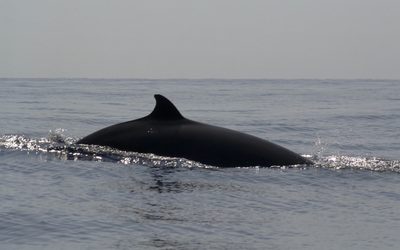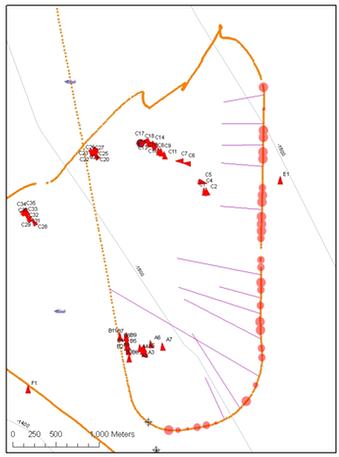Mediterranean Beaked Whale BRS Cruise: No Tags, New Passive Monitoring Technique
Bioacoustics, Science, Sonar Add commentsA five-week beaked whale Behavioral Response Study in the Mediterranean concluded in early September with a mixed bag of results: while researchers were unable to affix D-tags to any beaked or pilot whales, they were quite successful in using a new mobile Passive Acoustic Monitoring system which could be very useful in years to come. The study was largely aiming to track whales’ responses to various (low to moderate) levels of mid-frequency active sonar sounds using D-tags on the animals; previous Behavioral Response Studies using such “controlled exposures” have taken place on Navy instrumented ranges where the local populations are presumably familiar with sonar sounds, so they may respond differently than whales who have not heard these sounds before. However, due to many periods of rough seas, as well as the inherent difficulties of finding, getting close to, and attaching tags to beaked whales (who dive for over an hour and come to the surface only briefly), no D-tags were deployed on whales, and no controlled exposures took place. However, a document prepared before the cruise, summarizing previous BRS results, is well worth reading: see especially page 8, which includes a detailed analysis of beaked whale responses to sonar and orca sounds: in both cases, the whales cut short foraging dives, but returned to the surface more slowly than normal, not more steeply as is sometimes assumed, and they clearly moved directly away from the sounds.
However, researchers made the most of two other purposes of the cruise, both of which made use of a new passive acoustic monitoring technique. The research took place on an extremely quiet research vessel, from which two hydrophone streamers were deployed, each of which had two hydrophones on it. This gave listeners on the ship four separated sources from which to record and analyze sounds, so that most sounds could be quite well localized (direction and distance). In addition, researchers deployed floating “sonobuoys” that provided more listening stations during times when groups of beaked whales were nearby. This network of hydrophones provides much of the information that is provided by permanent bottom-mounted hydrophones on Navy ranges, and offers the potential to both find and monitor beaked whales in any location. The hydrophone arrays were also collecting basic sound budget data, which will provide a better sense of the noises (both natural and man-made) that ocean creatures hear on a routine basis. Click through for links to specific blog posts of interest, and a description of one day’s close encounter.
MED 09 Cruise blog home page (they will post reports here; you can sign up to “follow” the blog to be notified when this happens)
Post describing the double hydrophone array, with some recordings
Another post on the hydrophone array’s capabilities
Account of a difficult day in which whales were close but not tagged
Detailed account of a day of following a group; excerpt and image below is from this post
The image to the left shows a sequence during today’s focal follow. It is a bit of a complicated figure (you may need to blow it up a bit) with a lot going on (there was!). But it is a great example of how we can use all our tools to follow animals that dive for over an hour to great depth and then re-spot them at the surface and track them for hours. The sequence began with the ship in the northwest (upper left) corner of the figure and moving along at 6 knots (note the orange dots showing our position being spaced further apart than the rest of track where we were going slower). As we moved to the southeast, the group of two adults was spotted visually during their brief surface intervals. The red symbols with “A” and “B” labels are multiple positions of the same two whales during two surfacings in the same general area. After the animals went down on a deep feeding dive, we passed their spot and dropped a sonobuoy to monitor near that location (small circle with crosshairs along our track). We then moved around the spot monitoring with multiple arrays of listening sensors towed slowly (note our orange position markers being closer together) and began tracking them acoustically. The red circles on our track indicate when the acoustics team heard beaked whale clicks (the bigger the circle the stronger the sounds) and the purple lines show the direction from which they think the sounds are coming. We moved slowly along and kept the group on our port (left) side with very consistent detections – and the acoustics team could even tell that it was two animals. As we approached 30 min of clicking we felt confident enough of where they were and where they would come up that we deployed our tag boat and positioned them accordingly. When the animals re-emerged (positions C1-C5), we had our tag boat about 500m away, despite the fact that the animals were down for 79min and had moved 1500m in directly the opposite direction we had been traveling! As you can see from the increasing number of the “C” sightings in clusters (“E” was another single animal) we moved with the group over multiple other surface intervals between the multiple “shallow” dives (shallow is relative for beaked whales since they can be over 500m) that the animals do before deep feeding dives. The tag boat had several excellent chances, but the animals banked away several times in the last few moments before the tag could be attached. Eventually the group went on another feeding dive and we tracked them again by listening and had a bead on where they would surface. Just at that time, though, the winds tripled very suddenly (we saw the wind line coming) and the tag boat had to be recovered.


